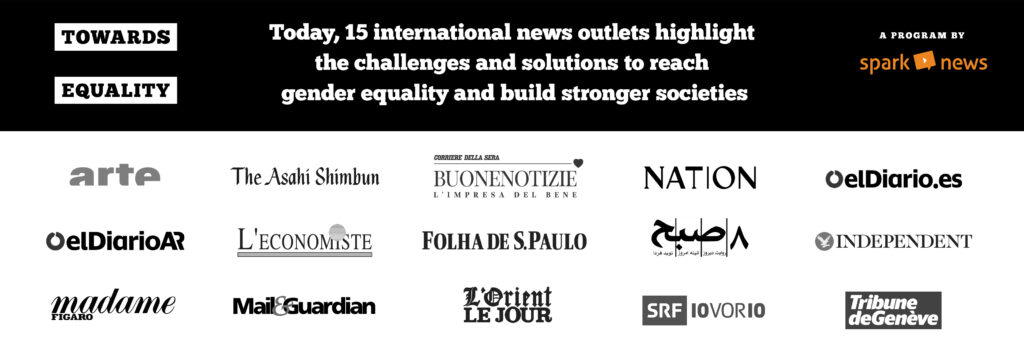(John McCann/M&G)
Twenty-six years after the Beijing Declaration and Platform for Action, which set the international target for reaching gender balance in political decision-making, women are still underrepresented across all levels of power.
You can find the UN world map of political representation as of 1 January 2021 here.
On average, globally, women hold 25.5% of both houses combined. The gap is actually wider in the Pacific region (20.9%), the Middle East and North Africa (17.8%) and Asia (20.4%), and narrower in the Americas (32.4%) and Europe (30.4%). In sub-Saharan Africa the average is nearly equal to the global average (25%).
Only two countries in the world have more women legislators in the lower house than men (Rwanda and Cuba) and one has 50:50 parity in parliament (UAE), as of 1 January 2021.
The only three countries that have more women than men in the senate are Australia (51.3%), Antigua and Barbuda (52.9%), and Bolivia (55.6%), followed closely by Mexico (49.2%).
Only 22 of 193 countries have a women as head of government (Bangladesh, Barbados, Belgium, Denmark, Estonia, Ethiopia, Finland, Gabon, Georgia, Germany, Iceland, Nepal, New Zealand, Norway, San Marino, Serbia, Singapore, Slovakia, Switzerland, Trinidad and Tobago), nine of whom are also head of state.
According to the UN, 119 countries have never had a woman leader, which underlines that, at the current rate, gender equality in the highest positions of power will not be attained for another 130 years.
In 2021, only 13 countries have 50% or more women in ministerial positions (Nicaragua, Austria, Belgium, Sweden, Albania, Rwanda, Costa Rica, Canada, Andorra, Finland, France, Guinea-Bissau and Spain). Globally, most women ministers tend to hold portfolios linked to family and children’s affairs, social affairs, environment, employment and gender equality.
Eight-two percent of women parliamentarians who participated in a study conducted by the Inter-parliamentary Union in 39 countries across five regions in 2016 reported having experienced some form of psychological violence (remarks, gestures and images of a sexist or humiliating sexual nature made against them or threats and/or mobbing) while serving their terms.
But, according to Cambridge University research, women legislators are more likely to advocate for policies that support education and health; they are also more likely to pass and implement legislation that advances gender equality, including laws on domestic violence, rape and sexual harassment.
According to the Council on Foreign Relations, when women’s parliamentary representation increases by 5%, a country is almost five times less likely to respond to an international crisis with violence. Within countries, women’s parliamentary representation is associated with a decreased risk of civil war and lower levels of state-perpetrated human rights abuses, such as disappearances, killings, political imprisonment: and torture.
Towards Equality’s media partners’ countries up close:
In Afghanistan (which ranks 71 of 193 countries analysed by the UN for gender parity in parliament), women currently hold 27% of the lower house and 27.9% of the senate or upper house in parliament (see Afghanistan’s piece on Women’s share in parliament here). Women hold 6.5% of the country’s ministerial positions (two of 31).
In Argentina (which ranks 18), women currently hold 42.4% of the lower house and 40.3% of the upper house. A woman is currently speaker of parliament. Women hold 18.2% of the country’s ministerial positions (four of 22).
In Brazil (which ranks 142), women currently hold 15.2% of the lower house and 12.4% of the upper house. Women hold 10.5% of the country’s ministerial positions (two of 19).
In France (which ranks 27), women currently hold 34.8% of the lower house and 12.4% of the upper house. Women hold 50% of the country’s ministerial positions (nine of 18).
In Italy (which ranks 35), women currently hold 35.7% of the lower house and 34.4% of the upper house. A woman is currently speaker of parliament. Women hold 36.4% of the country’s ministerial positions (eight of 22).
In Japan (which ranks 166), women currently hold 9.9% of the lower house and 23% of the upper house. A woman is currently speaker of parliament. Women hold 10% of the country’s ministerial positions (two of 20).
In Kenya (which ranks 105, tied with Fiji and Cambodia), women currently hold 21.6% of the lower house and 12.4% of the upper house. Women hold 31.8% of the country’s ministerial positions (seven of 23).
In Lebanon (which ranks 183), women currently hold 4.7% of the parliament (MPs chamber). The country doesn’t have a senate or upper house. Women hold 31.6% of the country’s ministerial positions (six of 19).
In Morocco (which ranks 114), women currently hold 20.5% of the lower house and 11.7% of the upper house. Women hold 15.8% of the country’s ministerial positions (three of 19).
In South Africa (which ranks 12), women currently hold 45.8% of the lower house and 41.5% of the upper house. A woman is currently speaker of parliament. Women hold 48.3% of the country’s ministerial positions (14 of 29).
In Spain (which ranks 16), women currently hold 44% of the lower house and 40.8% of the upper house in Parliament. A woman is currently speaker of parliament. Women hold 50% of the country’s ministerial positions (11 of 22).
In Switzerland (which ranks 20), women currently hold 42% of the lower house and 26.1% of the upper house in Parliament. Women hold 42.9% of the country’s ministerial positions (three of 7).
In the UK (which ranks 39, tied with Cameroon) women currently hold 33.9% of the lower house and 27.9% of the upper house. Women hold 23.8% of the country’s ministerial positions (five of 21).

